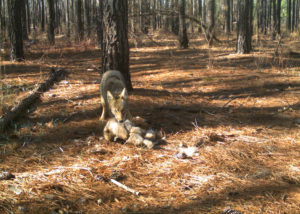Guess who’s coming to dinner: Exploring the factors that influence wildlife scavenging
September 21, 2017
Writer: Vicky L. Sutton-Jackson, 803-725-2752, vsuttonj@srel.uga.edu
Contact: Kelsey Turner, 803-725-5329, klturner@srel.uga.edu; James Beasley,
803-725-5113, beasley@srel.uga.edu

Aiken, S.C. – Wildlife scavengers are constantly on the lookout for their next meal, but now researchers at the University of Georgia’s Savannah River Ecology Laboratory have a better idea not only of who eats what, but also when and where, thanks to high-tech cameras that helped them explore scavenger behavior.
Scavenging ecology is far from an alluring science, but scientists at SREL and UGA’s Warnell School of Forestry and Natural Resources say that scavengers play an important role in the food web, and they even help reduce the spread of some diseases.
“Scavengers are nature’s garbage disposals, cleaning up dead animals—some of which are diseased—from the landscape,” said James Beasley, an assistant professor at SREL and Warnell and co-author of the study, which was published recently in the journal Ecology.
The research team found that three factors—habitat type, carcass size and season—interact to influence who shows up from the scavenger community, such as coyotes, vultures, hawks, mice, raccoons and foxes.
These factors influence a scavenger’s ability to find a carcass, or carrion, and how quickly they find and consume it.
The team looked at 380,000 images of scavenging activity taken during two seasons, a summer and winter near Aiken.
The images captured the scavenging of small, medium and large carcasses—rats, rabbits and pigs—in four diverse landscapes that ranged from open fields to tall pines.
Beasley said that common thought is that wildlife nutrition is sustained from predator behavior, but scavenging is a major source of nutrition in an ecosystem. Any alteration in the dynamics could remove a nutrient resource that helps to sustain a population.
“There are many factors that influence what happens to carrion in the environment. But, aside from temperature, many of these factors are not considered in most scavenging studies,” Beasley said.
Kelsey Turner, study co-author and doctoral student at SREL and Warnell, said all of these factors must be taken into consideration.
“If we aren’t looking at all possible variables, we might not be getting the whole picture, which could have implications on how we understand food web dynamics and issues like disease spread,” she said.
The researchers said a startling case of disease spread occurred in Southeast Asia after vultures—a top scavenger—were unintentionally poisoned. The mass elimination of the scavenger, though unintended, ignited a rabies outbreak.
Of the various interacting factors, the time of year had the most visible impact on scavenging efficiency—defined by the researchers as the percentage of carcasses fully or partially consumed by wildlife. During the warm season, 65 percent of the carcasses were scavenged. In the winter the number increased to 88 percent.
The size of a carcass and the season were also linked. While there was no real difference in scavenging of large carcasses, the scavenging of small and medium carcasses was close to 40 percent higher during colder months.
Turner attributes these differences to a decrease in scavenging from insects and bacterial communities during the colder months, which allows wildlife more time to find and consume carcasses.
The diversity of scavenger species, or who showed up, was mostly influenced by the type of habitat and the size of the carcass.
Small carcasses were usually consumed by small to mid-size mammals which included raccoons, Virginia opossums, foxes, coyotes and wild pigs.
Mid-size carcasses were primarily consumed by vultures, crows and hawks. Large carrion were generally consumed by coyotes, vultures and eagles.
Unexpected scavengers included the rarely sighted golden eagle and the southern flying squirrel.
As the team predicted, larger carcasses remained on the landscape longer, requiring more energy or effort for scavengers to consume. Carcasses placed in more visible and easier-to-reach open habitats were found 50 percent sooner than those placed in habitats obscured by canopy.
Although the study was conducted in a southeastern U.S ecosystem, Turner said temperature, carcass size and habitat type would all interact to produce similar results regardless of the geographic region.
Additional details on who scavenged where can be found in the study at
http://esajournals.onlinelibrary.wiley.com.proxy-remote.galib.uga.edu/hub/journal/10.1002/(ISSN)1939-9170/
Additional authors on the study include Erin F. Abernethy, Oregon State University; Olin E. Rhodes, Jr., SREL; and Mike Conner, Joseph W. Jones Ecological Research Center.
